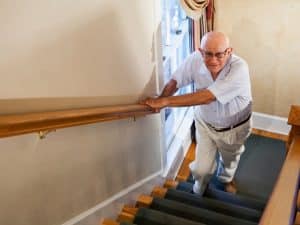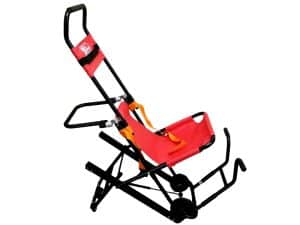A home stair lift can be a game-changer for anyone with limited mobility — but only if it’s designed with safety and reliability for daily use. Not all lifts offer the same level of security or ease. Choosing poorly can create new risks where you expect relief. This blog explores how safety varies between stair lift models, what issues affect long-term use, and which features make a difference. If you’re aiming to prevent falls and maintain independence at home, you need to know what separates a safe lift from a risky one.
Why are daily stair trips a safety concern for many seniors?
Even short staircases pose major risks for older Australians. As mobility and balance decrease with age, navigating stairs becomes physically taxing and mentally stressful. Here are the most common factors that make daily stair use dangerous:

- Loss of lower body strength: Reduced leg power limits stair-climbing stability.
- Unpredictable fatigue: Energy dips during the day make familiar movements hazardous.
- Joint pain and stiffness: Knees and hips often lock or weaken mid-step.
- Inconsistent lighting and handrails: Dimly lit spaces and narrow handrails create fall hazards.
These everyday issues can make a home feel like an obstacle course. That constant mental and physical strain wears people down. Over time, many avoid stairs altogether or take risky shortcuts. Both choices increase injury risk and reduce confidence. Many seniors don’t realise the toll this takes until a near-miss or accident forces a reassessment.
What risks increase when a home stair lift lacks safety features?
Choosing a stair lift without built-in safety functions is like buying a helmet without straps — it may look protective, but it can’t do the job when it counts. Here are the top safety gaps in underperforming stair lifts:
- No seatbelt or restraint: Riders slide forward during starts or stops.
- Weak sensors or none at all: Lifts keep moving when something’s in the way.
- Low-quality track stability: Wobbling during motion triggers anxiety or imbalance.
- Lack of braking mechanisms: Quick stops can feel like jolts, not control.
When these flaws go unnoticed, the user begins to distrust the equipment. That stress turns every ride into a guessing game. If you’re researching affordable mobility lifts for home stairways, review the safety specs first, not the price tags.
How does improper lift design impact long-term use at home?
A lift might seem great at first, but it reveals serious flaws after weeks of use. Poor design slowly erodes both confidence and comfort. Here are the design elements that hurt long-term safety:
- Non-intuitive controls: Buttons that are small, stiff, or badly placed frustrate users.
- Lack of seating support: No back or side support causes slouching or instability.
- Too-narrow seating: Larger users feel pinched, increasing anxiety during use.
- Visible moving parts: Exposed gears or motors appear industrial and intimidating.
When discomfort builds ride by ride, seniors may stop using the lift altogether. This reintroduces the daily hazards associated with using stairs. For ongoing safety, look into fall prevention with home stair mobility aids that emphasise function as much as form. While some stair lift systems are permanently installed in homes, many users opt for portable stair climbers that offer comparable safety features with greater flexibility. These devices are often used in residential, aged care, and emergency settings as adaptable alternatives to fixed systems.
What essential features improve safety in a home stair lift?
When selecting a stair lift, it’s the built-in safety features — not just the mechanics — that determine how well it performs over time. The most reliable models combine innovation with comfort and adaptability. Here are the top safety-enhancing features to look for:
- Dual-seat restraint system: Two seatbelts provide added peace of mind during transit, especially on longer flights.
- Stable under-track positioning: With the track running beneath the user, balance and weight distribution are noticeably improved.
- Handle-mounted control system: Simplifies operation with clear, responsive controls right where you need them.
- Electronic track angle adjustment: Adapts on the go to different stair gradients using a smart actuator.
- Raised seating and extended handles: Improves both entry comfort and caregiver access for support.
- Energy-efficient motor: Powers over 1,000 steps per charge, reducing the need for constant recharging.
- Compact folding design: Separates or folds down for easier transport and storage between uses.
These design choices don’t just enhance functionality — they build trust with every ride. If safety is your top concern, focus on lifts that balance control, durability, and rider comfort while actively preventing common household mishaps. You’ll also appreciate how these tools help in improving personal safety through home mobility tools, especially when recovery from a fall isn’t an option.
Can a stair lift reduce fall-related hospital visits?
Falls are one of the top reasons Australians over 65 end up in hospital, and stairs are often the culprit. However, consistent lift use can remove those hazards entirely. Here are the hospital risks that stair lifts directly reduce:
- Trip-and-slip incidents: Seated rides remove foot placement errors.
- Exhaustion-based falls: The lift does the heavy work without causing fatigue.
- Unseen obstacles: Lift tracks offer predictable, controlled movement.
- Night-time missteps: Backlit or auto-start systems improve visibility and control.
Safety Hazard | Without Lift | With a Stair Lift |
Fatigue-related falls | High Risk | Significantly Reduced |
Poor stair lighting | Moderate | Neutralised |
Balance instability | Frequent | Rare |
Unexpected items on the stairs | Common | Eliminated via sensors |
Reducing these incidents saves more than money — it protects independence. It’s one of the most tangible pros of using a lift every day. For carers, it reduces anxiety and physical support duties during stair use. This is why accessible home lift options for limited mobility must always include a certified setup, not just certified parts.
Final thoughts on selecting a safe home stair lift
Safety isn’t a bonus feature — it’s the baseline. When evaluating a stair lift, look beyond product pages. Ask how the lift behaves under stress. Consider the user’s habits, health conditions, and layout of the home. Prioritise design that aligns with how — and when — the lift will be used.
If you’re comparing options or need more clarity on what features matter most, you can learn more from the team at Stair Climbers, who offer practical guidance tailored to your home and needs.

